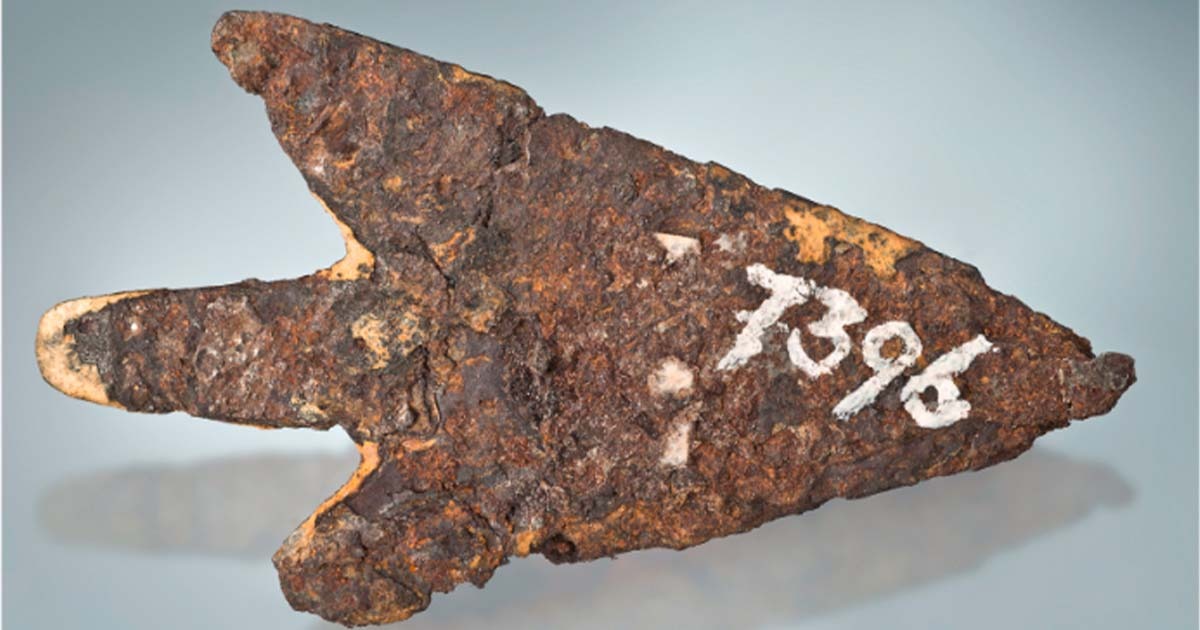
Swiss scientists, led by geologist Beda Hofmann from the National History Museum of Bern, identified a small, rusty iron arrowhead from the Bronze Age, dated around 900 to 700 BC, that was undeniably not of earthly origin.
To find this extraordinary artifact, the Swiss team focused on examining pre-Iron Age objects from different sites near Lake of Biel in Switzerland.
They managed to unearth the iron arrowhead from a settlement called Mörigen, a tiny ancient community situated just five miles away from Twannberg, where it had been buried since the 19th century. Twannberg is the place where a huge meteorite hit the earth over 10,000 years ago, way before the last Ice Age ended.
This meteorite impacts scattered iron pieces all around the area. So, it makes sense that the people living in Late Bronze Age settlements like Mörigen might have collected this iron to use for themselves.
More details about the arrowhead
The very small and heavily rusted arrowhead measured only 1.5 inches long and weighed just one-tenth of an ounce. It had traces of pitch on it, probably taken from a birch tree, which was likely used to attach it to a wooden arrow.
Traveling through space for millions of miles and then covering an additional thousand miles on Earth, the meteorite material used to make the arrowhead underwent scientific testing by Swiss researchers to uncover its metallic composition.
The results were quite telling, revealing that it had once been on a journey across our solar system. The main materials were iron and nickel, a combination commonly found in meteorites.
Moreover, the scientists found traces of a radioactive isotope called aluminum-26, which can only form in the weightless vacuum of space and does not occur naturally on our planet.
Meteorite iron used in the arrowhead
Initially, the researchers were pleased to discover what they expected – that the arrowhead was made from meteoritic iron. However, after conducting a detailed analysis, they made an unexpected discovery.
The iron in the arrowhead did not come from the nearby Twannberg meteorite debris field, as they had assumed. Instead, it originated from a different meteorite impact site where the debris had a slightly different composition.
The specific type of meteorite responsible for the iron in the Mörigen arrowhead is known as an IAB meteorite, containing a mix of meteoric iron and silicate inclusions.
Only three such meteorites have been found to strike Eurasia in ancient times, and they were discovered at far-off archaeological sites: Bohumilitz in Czechia, Retuerte de Bullaque in Spain, and Kaalijarv in Estonia.
After carefully studying the timing and features of the meteorite impacts, the Swiss scientists came to a strong conclusion. The metal used for the arrowhead probably originated from the Kaalijarv event in Estonia.
This meteorite hit the Earth around 1,500 BC and scattered variously shaped fragments in the nearby areas. These fragments were likely easy to heat and shape into small tools or weapons.
Evidence of ancient trade network
The Estonian site where this meteorite struck is quite far from the Bronze Age settlement at Mörigen – about 1,000 miles away. This finding provides clear evidence that an ancient trade network linked central Europe with far-off lands, including those in the northern regions.
It’s worth mentioning that the iron found in the arrowhead also matches the iron associated with the IAB meteorite strikes in Spain and Czechia. So, although it’s highly likely that the arrowhead’s metal came from Estonia, we can’t be completely certain just yet.
Regardless of its precise source, it’s probable that other pre-Iron Age artifacts out there were made from the same celestial material.
Indeed, one thing we can be certain of is that the Kaalijarv impact event generated a significant amount of usable metal fragments.
If this meteorite was indeed the source of the iron in the Mörigen arrowhead, then it is highly likely that numerous similar objects exist out there. These objects could have been exchanged through prehistoric long-distance trade networks, potentially leading to their discovery in distant and astonishing locations.
More objects made from meteorite iron
In the Bronze Age, before people discovered how to extract iron from iron ore using fire, they relied on iron from meteorites as their only source of this strong and durable metal.
Finding iron from meteorites wasn’t easy, but the resourceful Bronze Age folks managed to discover them and melt the metal to create useful items like tools, weapons, and jewelry.
The Willamette Meteorite, weighs 15.5 tons, and is an iron meteorite pic.twitter.com/eb4m4kshzr
— Jon de Ros (@jonderos) July 28, 2023
Since the 19th century, archaeologists have uncovered just 54 artifacts made from meteoric iron at 21 different sites across Eurasia and North Africa.
These discoveries have been made in eight different countries: Greece, Turkey, Iraq, Lebanon, Syria, Egypt, Russia, and China. Such a wide geographical spread strongly suggests that these objects were traded over long distances at times.
It’s quite likely that more of these artifacts are still out there, perhaps hidden in private or public collections around the world or in future archaeological sites yet to be unearthed.
Given that meteorites have been impacting the Earth for a very long time and all around the globe, it’s possible that these artifacts will eventually be found on every continent.
See all the latest news from Greece and the world at Greekreporter.com. Contact our newsroom to report an update or send your story, photos and videos. Follow GR on Google News and subscribe here to our daily email!



